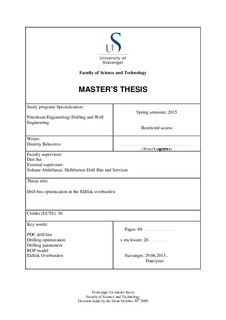| dc.contributor.author | Belozerov, Dmitriy | |
| dc.date.accessioned | 2015-09-22T10:29:33Z | |
| dc.date.available | 2015-09-22T10:29:33Z | |
| dc.date.issued | 2015-06-29 | |
| dc.identifier.uri | http://hdl.handle.net/11250/301097 | |
| dc.description | Master's thesis in Petroleum engineering | nb_NO |
| dc.description.abstract | Drill bits are a part of the well program. It is the major tool that does a cutting/crushing action at the end of the drillstring and highly affects the overall drilling performance. The following aspects can be improved by implementing a better drill bits solution: drilling efficiency, steerability, stability.
Eldfisk is an oil field located in the Norwegian sector of the North Sea. A special interest represents the 12 ¼” section, called “overburden”. To a large extent it consists of interbedded formations with highly varying rock strength: soft shales and hard stringers of different origin. A problem that arises is that the bit designed for specific applications will be used to drill formations that it is not completely suited for. Also the overburden is highly overpressured, and these are not the only drilling issues in the section.
The main objectives of this study is to find the ways to optimize drill bits performance in the Eldfisk overburden by introducing a better drill bit solution or better drilling practices.
The group of eight has been analyzed in order to find the best 12 ¼” drill bit solution previously used in the field. It was the matrix-body PDC bit GTD65D which drilled the section with the record overall ROP of 102.8 fph and was pulled out of hole with a minor dull: a few chipped cutters. After evaluating drill bit dynamics relevant for the applications, a new bit design has been proposed: the steel-body bit SFD65D that could potentially increase the bit efficiency due to several features, such as impact shocks damping-effect of the steel, 59% increase in Junk Slot Area, 37% increase in Normalized Face Volume, and some others.
In order to identify the main operational parameters affecting the drill bits performance a multiple regression approach has been utilized. An empirical ROP model has been developed based on the surface mud-logging data from the reference wells. However it has showed only a low correlation with the actual penetration rates: 54%. After adjusting the input data and the model itself the correlation has been improved to 78%. Even though the model has a valid algorithm, the PDC bits performance cannot be easily modelled for such highly-interbedded formations as the Eldfisk overburden. Generally, special transitional drilling procedures should be used whenever a hard stringer is encountered.
Several assumptions have been made in this thesis, such as generalizing formation characteristics and selecting specific offset wells for the study. The drill bits optimization analysis can be performed by different methodologies. | nb_NO |
| dc.language.iso | eng | nb_NO |
| dc.publisher | University of Stavanger, Norway | nb_NO |
| dc.relation.ispartofseries | Masteroppgave/UIS-TN-IPT/2015; | |
| dc.subject | petroleumsteknologi | nb_NO |
| dc.subject | boreteknologi | nb_NO |
| dc.title | Drill bits optimization in the Eldfisk overburden | nb_NO |
| dc.type | Master thesis | nb_NO |
| dc.subject.nsi | VDP::Technology: 500::Rock and petroleum disciplines: 510::Petroleum engineering: 512 | nb_NO |
